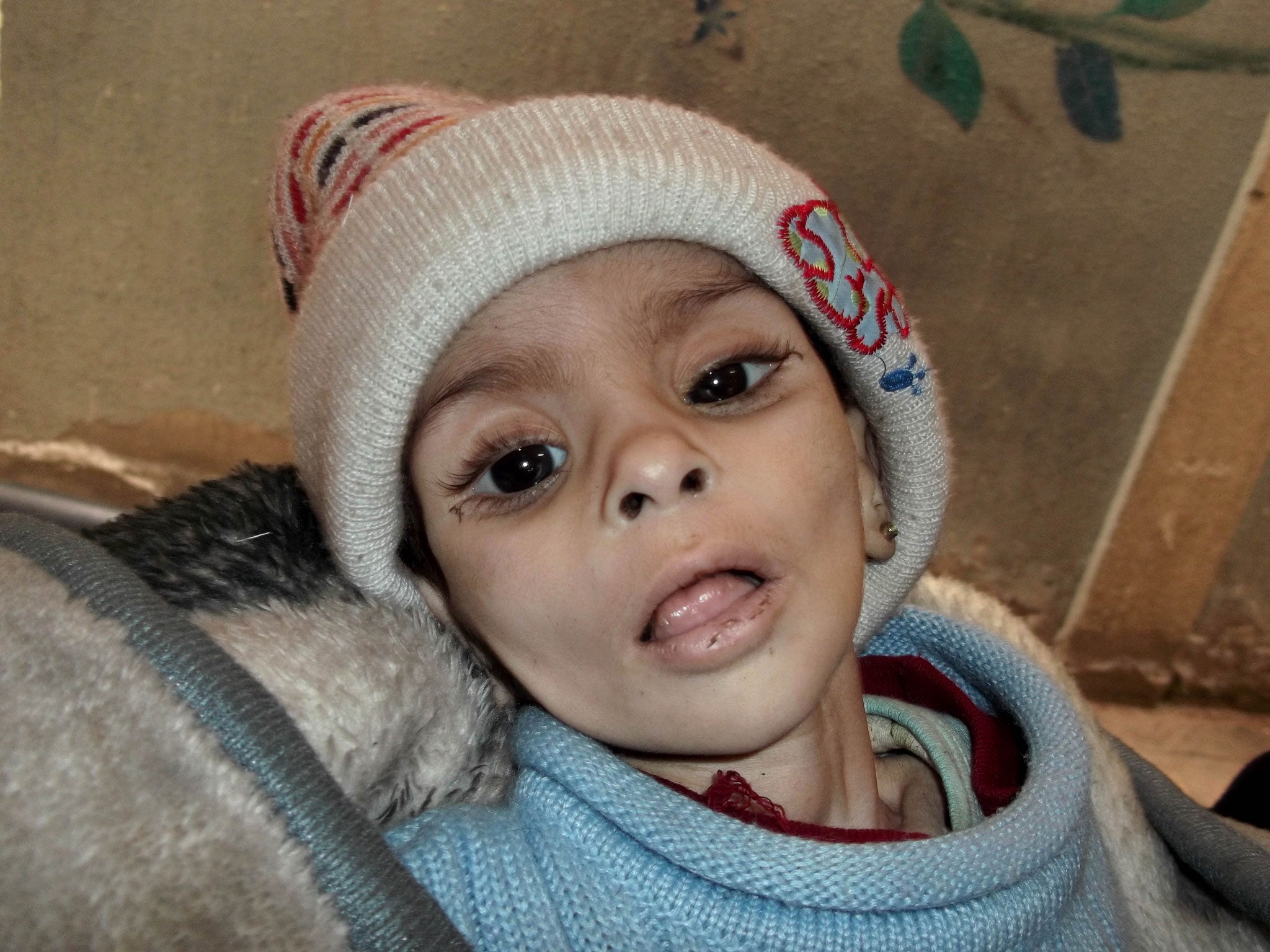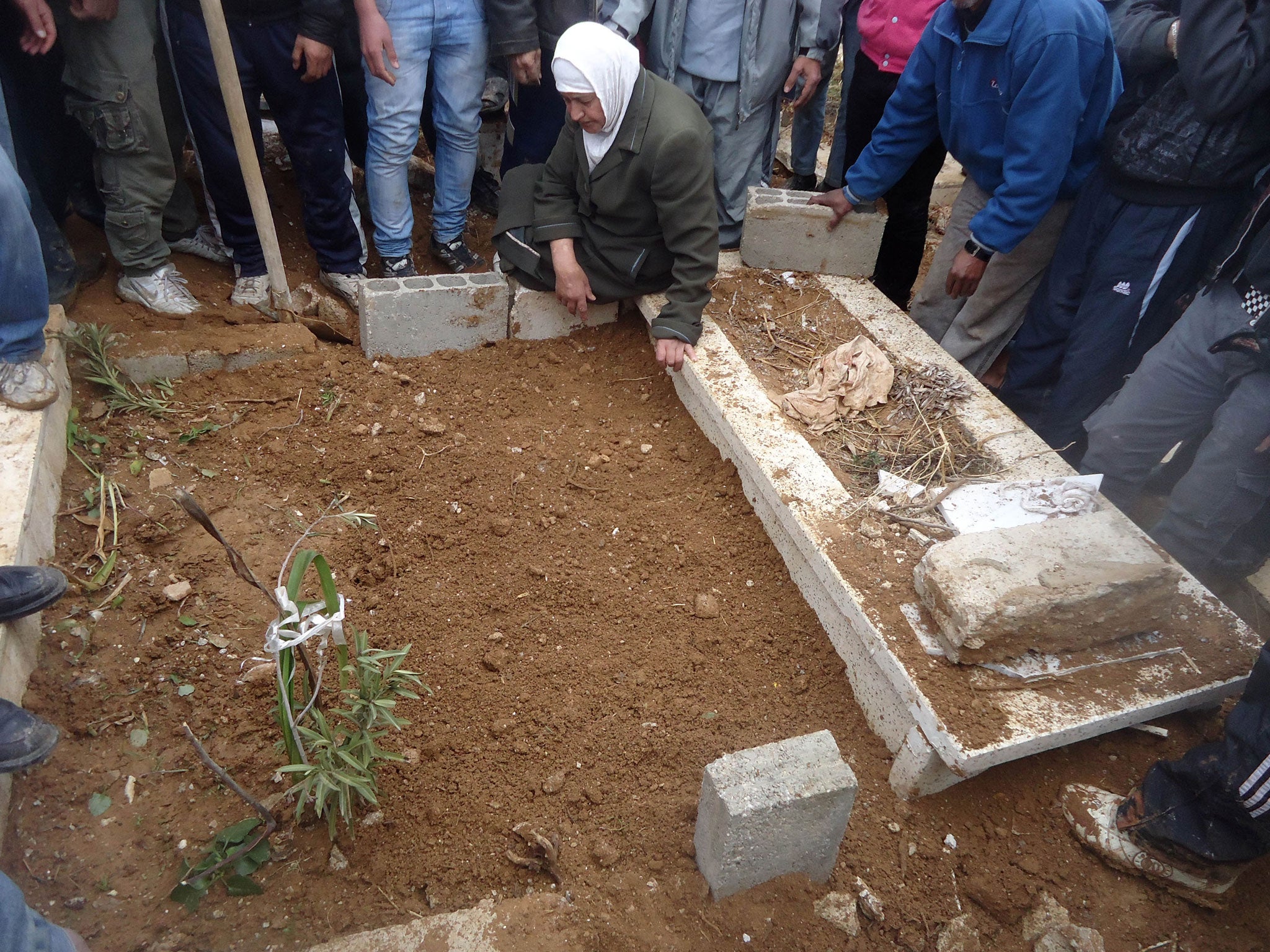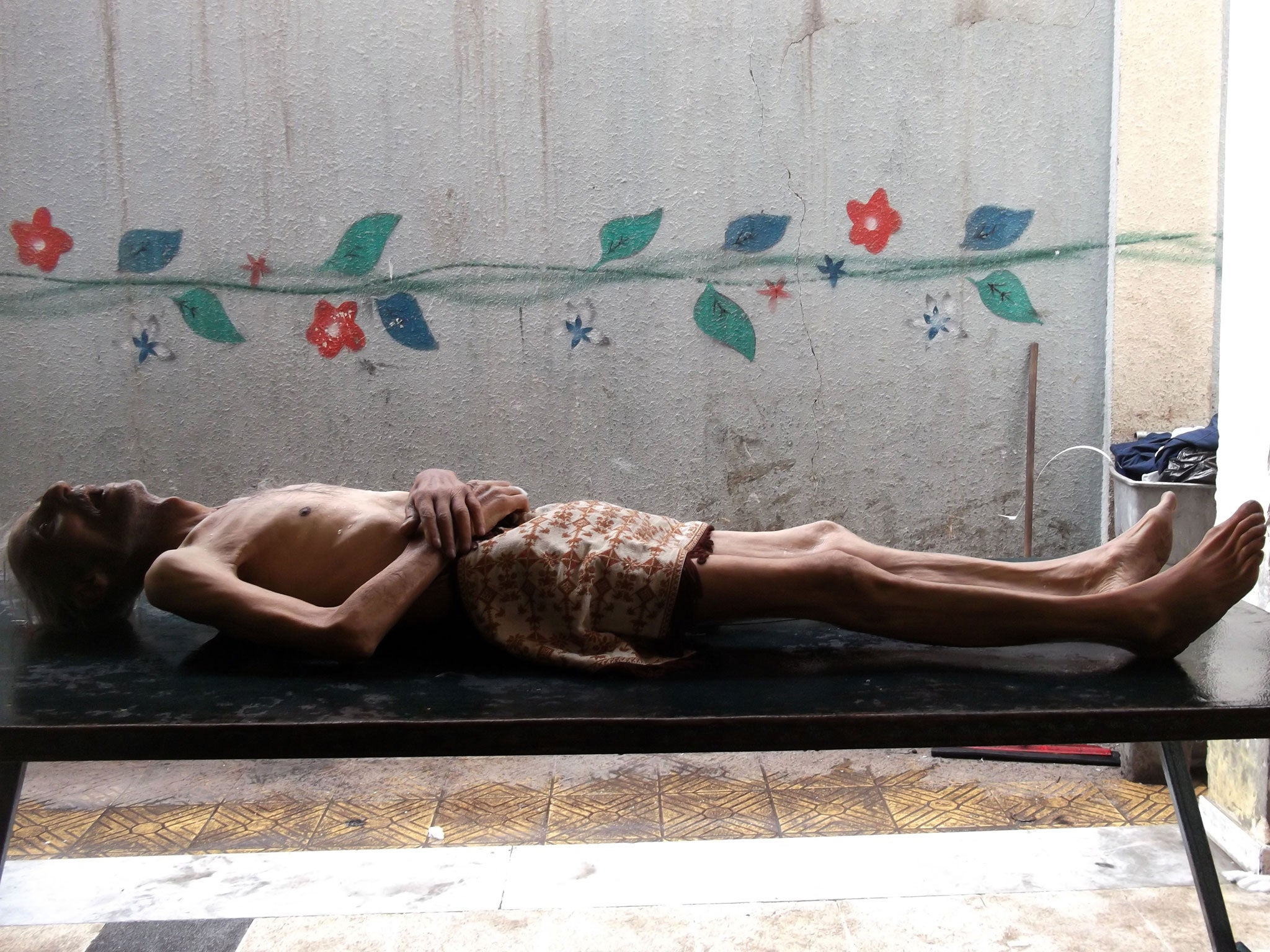Innocent, starving, close to death: One victim of the siege that shames Syria
Months of encirclement by the Syrian army has cut off the 18,000 people in Damascus's Yarmouk refugee camp from supplies and medical aid, reducing them to subsisting on a diet of animal food, water with salt and instant noodles and leaves

Your support helps us to tell the story
From reproductive rights to climate change to Big Tech, The Independent is on the ground when the story is developing. Whether it's investigating the financials of Elon Musk's pro-Trump PAC or producing our latest documentary, 'The A Word', which shines a light on the American women fighting for reproductive rights, we know how important it is to parse out the facts from the messaging.
At such a critical moment in US history, we need reporters on the ground. Your donation allows us to keep sending journalists to speak to both sides of the story.
The Independent is trusted by Americans across the entire political spectrum. And unlike many other quality news outlets, we choose not to lock Americans out of our reporting and analysis with paywalls. We believe quality journalism should be available to everyone, paid for by those who can afford it.
Your support makes all the difference.Israa al-Masri was still a toddler when she lost her battle to cling to life. But the image of her face, pictured just minutes before she finally succumbed to starvation, is becoming the symbol of a wider nightmare.
For Israa, tongue swollen, wearing a chunky sweater and woollen hat that seem more substantial than she is, was just one of thousands of Palestinian refugees trapped and starving in Yarmouk refugee camp, Damascus.
Once Syria’s largest Palestinian camp, Yarmouk has been under siege for almost a year. Most of its 160,000 population fled following violent clashes in December 2012, but at least 18,000 have remained, and months of encirclement by the Syrian army, cut off from supplies and medical aid, have reduced them to subsisting on a diet of animal food, water with salt and and leaves. Women are shot at by snipers as they try to gather plants to feed their children. Israa is one of at least 50 to have died from hunger-related causes since October.
“The people are now eating grass and have started to eat cat and dog meat as a routine meal,” says Qais Saed, 26, whose last meal was three days ago and consisted of water with some spices. He cannot recall the last time he was not hungry.
Pro-Assad Palestinian factions blame the presence of 2,500 rebel fighters in the camp for the length of the siege. Sheikh Mohamed Abu Khair, the imam of the camp’s Palestine mosque, sanctioned the eating of cats, donkeys and dogs in a fatwa in October after four people had died from malnutrition. That number has now risen to at least 50, says the Action Group for Palestine.
“According to our figures somebody is dying daily now,” says Neil Sammonds, Syria researcher at Amnesty International.

A local nurse told the organisation that since mid-November last year, when government forces took control of an area near the camp, several civilians, mainly women, have been killed by snipers while foraging for food in nearby fields.
“Every day we receive around four people who were shot by snipers while they were picking plants in the fields. The women say they prefer to risk their own lives to spare the children.
“On one occasion, we received a teenager, probably aged 16 or 17, who was shot dead. His father started talking to him and said: ‘You died for the sake of bringing hibiscus leaves for your siblings.’ It was heartbreaking,” she said.
Residents have recounted a scene of devastation and desperation inside the camp, which was originally built in 1957 to house thousands of Palestinians displaced by the 1948 Arab-Israeli war. Over time it turned into a bustling residential area, with Syrian as well as Palestinian inhabitants. But today it’s a far cry from the packed restaurants of downtown Damascus, just five miles away.
“There are no more people in Yarmouk, only skeletons with yellow skin,” Umm Hassan, a 27-year-old resident and the mother of two toddlers, told the Associated Press on Monday.
Videos uploaded to YouTube show angry and desperate residents venting their frustration. “We are tired; there is no food,” says one woman. Another holds up a bag full of leaves which is the only food she has to feed her four children.
“Residents including infants and children are subsisting for long periods on diets of stale vegetables, herbs, powdered tomato paste, animal feed and cooking spices dissolved in water,” says Chris Gunness, spokesperson for the UN Palestinian agency UNRWA.
People are so desperate that some are reportedly shedding family members in order to conserve resources. “One father threw his daughter on the street; we found the baby in the street,” says Abu Muhamed, 24 and an activist, who took the child to hospital. “People feel that psychologically they can do nothing.”

Reports of robbery, primarily of food, are rife. Contacting people inside the camp is difficult, as sustained electricity cuts have been plaguing the camp for nine months. There is also little water or heating.
“Residents are having to rely on going out on to terraces and burning furniture and branches to warm themselves in the open because wood fires cannot be resorted to indoors. There is a very infrequent supply of tap water – reportedly available for four hours only at intervals of three days,” says Mr Gunness.
Children such as Israa are at particular risk, aid agencies have warned.
“We are extremely worried about the fate of children trapped inside conflict zones in Syria, receiving little or no humanitarian assistance,” George Graham, Head of Humanitarian Policy at Save the Children, said: “Intentionally starving a population by refusing humanitarian access is unacceptable and a grave violation of the laws of the war.”
The lack of electricity in the camp is also affecting the single hospital that is still in operation, which has in addition run out of supplies. The absence of medical care has led to several women dying in childbirth.
As a result of severe malnutrition, residents, especially children, are now affected by diseases such as anaemia, rickets, and kwashiorkor [a disease of malnutrition related to protein deficiency]. The camp has also not been able to receive vaccines, most notably for polio. That disease has returned to Syria after having been eradicated more than a decade ago.
An UNRWA aid convoy carrying 10,000 polio vaccines and food for 6,000 people was forced to turn back as it tried to enter the camp on Monday, after its Syrian army security detail was repeatedly shot at. Despite the north area of the camp being easier to enter – as it is held by the regime – the Syrian government withheld permission, citing security fears. This forced the convoy to use the southern entrance and pass through some 10 miles of contested territory.
Residents suspect that opposition fighters viewed the presence of regime troops, including a bulldozer clearing the road for the six-truck convoy, as a provocation. On Monday, the Foreign Secretary William Hague said the deliberate obstruction of humanitarian aid to the Syrian people is “utterly unacceptable”.
The Foreign Office added that it will be pushing for the “lifting of sieges and access for humanitarian organisations and the immediate end to attacks on civilian areas and medical facilities and respect for international humanitarian law”.
Adding to Yarmouk’s misery, at least four people were killed in a barrel bomb attack. “The people were saying, if they can’t enter with food, maybe they can send it by plane. But what [Assad] sent was a bomb,” said Qais Saed.
Activists say around 1,000 people descended on the northern gate following the attack, but were stopped by sniper fire, in which one person died. The Independent couldn’t independently verify this claim.
More than 100,000 people have died in Syria’s bitter civil war since 2011 and millions more have fled the country.
The Syrian government is due to sit down with the opposition in Geneva on 22 January in what would be the first face-to-face peace talks between the two sides. Many have questioned how effective the talks will be, however, with many opposition groups boycotting them.
The agreement to allow the aid convoys to enter the areas was announced in Paris by the US Secretary of State John Kerry and the Russian Foreign Minister Sergei Lavrov, who are working to broker an end to the bloody civil war.
There is no sign, however, that help is close to arriving in Yarmouk.
“Why don’t they kill us with chemicals? It would be done in a few minutes. It’s better than this way,” said Abu Muhamed, an activist.
Syria images of starvation: Verifying the truth
The factors preventing food and medical aid from getting into the Yarmouk camp also make it unusually hard to verify reports and pictures coming out of it.
The UN Relief and Works Agency has spoken of “profound civilian suffering in Yarmouk, with widespread incidence of malnutrition and the absence of medical care”, and numerous sources confirm the severity of conditions in the camp.
But the only visual evidence of these conditions comes from within the camp – from videos posted on YouTube to images posted on Twitter or, in some cases, photographs sent directly to journalists. The suppliers are usually activists.
The image of Israa al-Masri (above), and of a funeral for other victims of the siege, were provided to an Associated Press (AP) reporter by the activist group Palestinians of Syria. The Independent spoke to the AP reporter, who said they had spoken to the person in the activist group who supplied a number of pictures from within Yarmouk camp, including the picture of Israa, whose image also appears in a separate YouTube video, which The Independent has seen.
Medical advice received by The Independent supports the view that the child identified as Israa does show signs of being “severely malnourished”.
Given the weight of evidence of extreme hunger within Yarmouk, there is no particular reason to doubt the authenticity of other images such as the one above, which is also taken from footage supplied by an activist group, and featured by Al Jazeera. But despite rigorous checks, there is still no sure way of verifying them.
Join our commenting forum
Join thought-provoking conversations, follow other Independent readers and see their replies
Comments